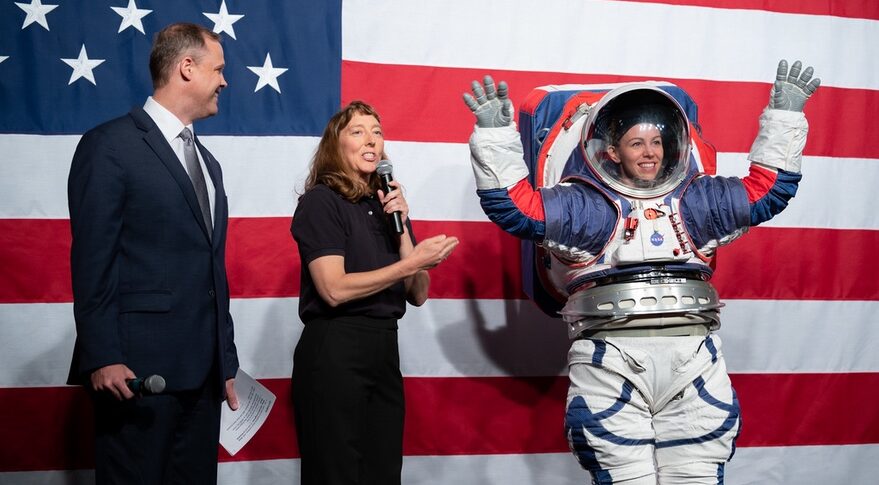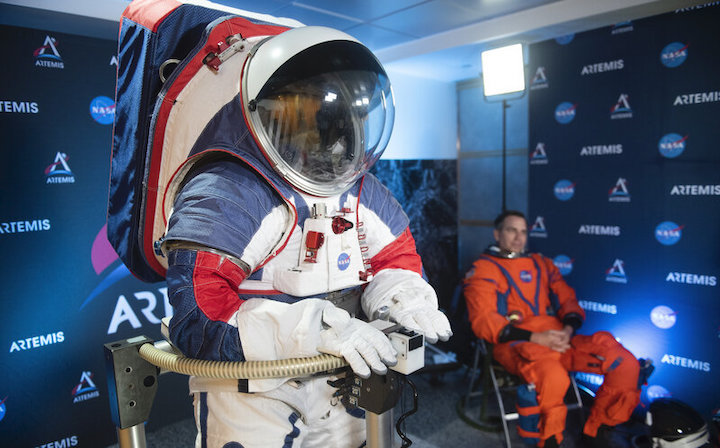12.08.2021

The next-generation spacesuits needed by the first moonwalkers in NASA's Artemis program will not be available until 2025 at the earliest and will have cost more than $1 billion to develop, the agency's Office of Inspector General reported Tuesday.
While November 2024 remains NASA's goal for obtaining two flight-ready spacesuits, known as xEMUs, "the agency faces significant challenges," the OIG said, including a 20-month delay in development and delivery of test suits, a space station demonstration version and two lunar flight suits.
"These delays - attributable to funding shortfalls, COVID-19 impacts, and technical challenges - have left no schedule margin for delivery of the two flight-ready xEMUs," the report concluded. "Given the integration requirements, the suits would not be ready for flight until April 2025 at the earliest."
"Moreover, by the time two flight-ready xEMUs are available, NASA will have spent over a billion dollars on the development and assembly of its next-generation spacesuits," the report said.
The inspector general said the spacesuit delays alone mean a lunar landing in 2024, a deadline imposed by the Trump administration, "is not feasible."
The conclusion comes after earlier reports that identified "significant delays" in other Artemis programs, including development of the Space Launch System rocket and Orion crew capsules needed to launch astronauts to the moon.
"Moreover, delays related to lunar lander development ... will also preclude a 2024 landing," the OIG said.
Under the Artemis program, NASA's Boeing-managed SLS rocket will boost Lockheed Martin-built Orion capsules to the moon where crews will either rendezvous with a small lunar space station, known as Gateway, or descend directly to the surface in a new lander being built by SpaceX.
The first SLS is being assembled, or "stacked," at the Kennedy Space Center and is expected to blast off on a maiden flight by the end of the year, sending an unpiloted Orion capsule on an automated trip around the moon and back.
The second Artemis flight, tentatively targeted for 2023, will send four astronauts on an around-the-moon shakedown flight before the first landing attempt in the Artemis 3 mission, presumably in the 2025 timeframe or later.
NASA's current spacesuits, or extravehicular mobility units — EMUs — were originally designed in 1974 for use during the space shuttle program. The suits were modified in the early 1990s for use outside the International Space Station.
The current xEMU spacesuit design effort is intended to replace the current suits with next-generation models that could be used on the space station, on and around the moon and, eventually, on Mars.
The new suits feature improved mobility, flexibility and communications. They will fit a broader population and will allow astronauts to work in vacuum for up to nine hours. The xEMUs feature 92 components being supplied by 27 different vendors.
Since 2007, the OIG reported, NASA has spent just over $420 million on spacesuit development. To finish development, NASA must obtain suits for testing and certification as well as a demonstration model that can be evaluated aboard the International Space Station.
"Going forward, the agency plans to invest approximately $625.2 million more, bringing the total spent on design, testing, qualification, an ISS Demo suit, two flight-ready suits and related support to over $1 billion through fiscal year (FY) 2025," the report said.
The OIG made four recommendations to streamline remaining development, reduce technical risks and keep the project in synch with other elements of the Artemis program as well as the International Space Station.
Quelle: CBS News
+++
Lunar spacesuits won’t be ready in time for 2024 landing

WASHINGTON — Spacesuits that NASA astronauts will need to walk on the moon won’t be ready in time to meet a 2024 lunar landing goal, NASA’s inspector general concluded.
In an Aug. 10 report, NASA’s Office of Inspector General (OIG) said the next-generation spacesuit the agency is developing for the Artemis program, known as the Exploration Extravehicular Mobility Unit (xEMU), won’t be ready for flight until at least April 2025, and may be subject to further delays.
“Given these anticipated delays in spacesuit development, a lunar landing in late 2024 as NASA currently plans is not feasible,” OIG stated in its report. It added, though, that other factors, such as delays in the development of the Space Launch System, Orion and Human Landing System (HLS), “will also preclude a 2024 landing.”
The report identified several factors for the delay, such as technical issues, funding shortfalls and impacts of the COVID-19 pandemic. While NASA has spent $420.1 million on new spacesuit designs since the Constellation program in 2007, and about $625 million more to complete development of the xEMU, funding for xEMU development in fiscal year 2021 was cut by 28% because of reduced funding for the lunar Gateway program, which hosts that work.
Those factors wiped out the 12-month schedule reserve for xEMU development. NASA now estimates the first two xEMU suits needed for the Artemis 3 mission won’t be completed until November 2024 and, given time needed for final launch preparations, would not be ready for flight until at least April 2025, even if the lunar lander and other components of the mission are complete. “As of June 2021, NASA had no contingency plans if the suits are not ready,” the report stated.
Schedule pressure created by moving up the lunar landing date in 2019 from 2028 to 2024 may have exacerbated problems. The report noted that, in March, work on a prototype suit was halted because of a component failure. Personnel blamed the problem on factors that included schedule pressure as well as faulty communications among team members and rapid growth of the project team.
Despite its problems, work on the xEMU suit is still far ahead of HLS, which creates its own difficulties. The report noted that project officials worry that design assumptions the suit project makes about the lander may turn out to be wrong. The mass budget for the suit was cut last year from 186.6 to 177.1 kilograms, which is forcing the project to redesign elements of the suit to meet that reduced mass.
The OIG report also raised concerns about NASA’s procurement strategy for the new suit. NASA previously planned a “hybrid contract approach” where it would have a single prime contractor for integration of the suit and multiple contracts for development and sustainment. NASA, though, announced earlier this year it would follow a commercial services approach for spacesuits, paying to use suits developed by companies, who will be encouraged but not required to use technologies developed for the xEMU.
That approach, the report added, also makes it unclear if the suits will also be designed for use on the International Space Station. The xEMU project had planned to make versions of the suit compatible for use on the station, replacing aging suits that have become a safety issue, as well as for activities at the lunar Gateway.
“However, with the evolving and competing requirements of the xEMU’s stakeholder programs and the Agency’s uncertainties about mission priorities, NASA is at risk of awarding a contract without clearly defining key technical requirements,” the report concluded.
The report made four recommendations for NASA, from extending the schedule of suit development and making sure xEMU suits can also be used on the ISS to finalizing an acquisition strategy for the suits. NASA, in a response included in the report, said it accepted the recommendations, although implementing them won’t be completed in some cases until next June.
Quelle: SN
----
Update: 23.08.2021
.
NASA Wants To Return To The Moon By 2024, But The Spacesuits Won't Be Ready

The two NASA spacesuit prototypes, one for exploring the surface of the moon's South Pole (left) and one for launch and reentry aboard the agency's Orion spacecraft, won't become a reality in time for a planned 2024 mission.
NASA won't be ready to send astronauts to the moon by 2024 as planned because, among other reasons, their spacesuits won't be ready, the agency's internal watchdog found.
NASA had officially planned to send astronauts back to the moon by 2024, but independent experts and its own acting administrator had already doubted that timeline was realistic.
In a report this month, NASA's inspector general found that because of delays in spacesuit development, "a lunar landing in late 2024 as NASA currently plans is not feasible." The report blames a lack of funding, the COVID-19 pandemic and "technical challenges" for the delay. The inspector general estimated that the earliest the spacesuits would be ready is April 2025.
The last time humans landed on the moon was in 1972. And the spacesuits NASA astronauts are still using are based on technology from the same era.
NASA has been developing new spacesuits for the last 14 years, which have so far cost $420 million. The agency is expected to spend another $625 million by the time just two flight-ready suits are ready in the 2025 fiscal year.
The spacesuits aren't the only reason that NASA won't get to the moon by 2024. The inspector general noted that delays involving the new Space Launch System rocket, the Orion capsule and the lunar lander all preclude reaching the moon on schedule.
In April, NASA chose SpaceX to build its lunar lander for $2.9 billion. But a competing company, Blue Origin, has repeatedly objected, which the inspector general noted has caused delays.
And on Thursday, after the inspector general report's release, work on the lunar lander was delayed again: suspended for 2 1/2 months in response to a lawsuit filed by Blue Origin.
The new moon landing is part of the Artemis program, which specifically aims to include a woman and a person of color among the people who will walk upon the moon's surface, whenever that may be. Later Artemis missions will attempt to establish a "base camp" for long-term exploration over one or two months. NASA saysthis would help inform future missions to Mars.
The moon landing had previously been set for 2028, but in 2019, the Trump administration pushed it forward by four years. NASA has yet to set an official new target date for the moon landing.
"Sending the first woman and first person of color to the lunar surface and establishing a long-term presence at the Moon under Artemis is a priority for NASA," a spokesperson told NPR in a statement. "The agency is evaluating the current budget and schedule for Artemis missions and will provide an update later this year."
Quelle: npr

